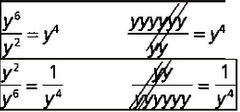![]()
![]()
![]()
Use LEFT and RIGHT arrow keys to navigate between flashcards;
Use UP and DOWN arrow keys to flip the card;
H to show hint;
A reads text to speech;
14 Cards in this Set
- Front
- Back
|
Law 1 |
When multiplying, if the bases are the same, add the exponents. Multiply the coefficients, but add the exponents. |
|
|
What is a coefficient |
The big numbers in front of the variables. It tells you how much of one variable there is. |
|
|
Law 2 |
When raising a power to a power, multiply the exponents. |
|
|
What is a constant |
A variable/number without exponent or coefficient. |
|
|
Law 3 |
If a constant is in parentheses with an exponent on the outside of the parentheses, the constant is also raised to that power. |
|
|
Law 4 |
When raising a fraction to a power, multiply the exponents in both the numerator and the denominator by the power. |
|
|
Law 6 |
Anything to the power of 0 is 1 (except 0 to the power of 0, that goes into philosophy apparently!) |
|
|
Law 5 |

When dealing with a fraction where the numerator and denominator are the same variable, you are to subtract the bigger exponent of the two variables from the smaller. The answer should be one variable. If the denominator's is bigger, the answer will still be a fraction, with a 1 as the numerator and a variable and exponent as the new denominator. |
|
|
Law 7 |
Anything (except 0) to a negative power becomes a fraction, with 1 over itself to the positive power. |
|
|
Law 8 |
When a base in the denominator is raised to a negative power, the base moves up to the numerator and the exponent changes to a positive. |
|
|
Law 9 |
A fraction to a negative power becomes its reciprocal to the positive power. Exponents inside the parentheses do not change sign when you flip the fraction. |
|
|
What do you do to the exponents when dividing like bases? |
Subtract the exponents. |
|
|
What do you do to the exponents when multiplying like bases? |
add the exponents. |
|
|
w-sd multiplicative inverse? |
The number that, when multiplied by a given number, gives 1 as the product. |

